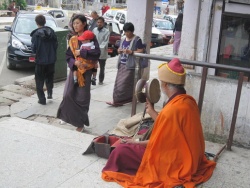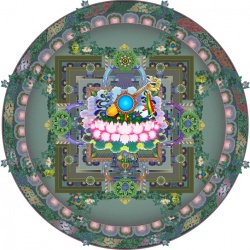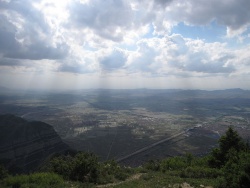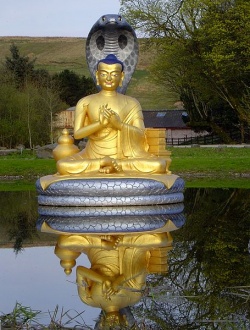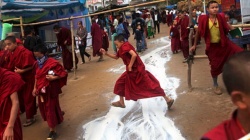The Buddhist Concept of World
Bhikkhu T. Seelananda
What is the World? In the history of man, there have been many philosophers and scholars who have had developed theories, speculations, imaginations and reasons of the “worlds”. But, what they talked of were mere reproductions of the earth and the heavenly bodies such as the sun, moon and the stars. When we think of world we talk about countries, ocean, mountains and so on. There are many definitions, or meanings of the world. If you look up “world” in a dictionary, you come across many meanings. In the [[[Wikipedia:Oxford|Oxford]] Dictionary] there were at least 9 meanings. Of those definitions there were 3 that are somewhat close to the real meaning of world however there is still a gap in the accuracy. Here are the three definitions:
1. The earth with all its countries, peoples and natural features.
2. A planet likes the earth; there may be other worlds out there.
3. The state of human experience; this world and the next. (This is the closest to the Buddhist concept of world).
In the Buddhist texts, the word used to denote the “world” or “cosmos” or the “universe” is loka. The Buddha has used the term on many occasions. At the end of his first sermon it is said that ten-thousand world system heard of this and there was an effulgence light in the world. According to the [[Discourse of Great Assembly (Mahā Samaya), for the great assembly held in the Great Wood in Kapilawastu many millions of deities came from ten thousand world systems. So according to Buddhist scriptures, there are thousands anywhere from 1000 to 2,000 and 3,000 to 10,000 world systems.
To help us to now understand how the Buddha has talked about the world; there is a definition he once shared with a certain monk named Samiddhi. This monk went to the Buddha and asked, ” Loko lokoti bhante vuccati kittāvatānukho bhante loko ti vuccati?” (Bhante world, world it is said, what is the meaning of world?). Then the Buddha replied, “Lujjatiti kho bhikkhu tasmā lokoti vuccati” (Monk, it is breaking up, it is disintegrating, therefore, it is called the world).
The terms: Lujjati, palujjati, bhijjati, nirujjati have more or less the same meaning. That is breaking, evanescent nature of all animate or inanimate things. In other words, this is impermanency. In accordance with the teaching of the Buddha everything is impermanent. So the world is nothing but disintegration. Before his death Albert Einstein himself accepted that everything is in a vibration. This whole system of the universe is nothing but a vibration. And the Buddha said further, “What is disintegrating? The eye is disintegrating, forms are disintegrating, eye consciousness is disintegrating, eye contact is disintegrating, and whatever feeling arises with eye-contact as condition that too is disintegrating. Then ear… nose… tongue… body…mind is disintegrating bhikkhu, therefore, it is called the world.” (S.N. 35.82.9).
What are the Internal and External Worlds? According to the Buddha, there are two worlds, the internal world and external world. Most of the time the Buddha has talked about the internal world. If one can understand the internal world one can understand the external world too. How can you understand the external world when you understand the internal world? Because, what we find in the internal world is the same with what we come across in the external world. In the discourse of the Exposition of Elements (M.N. 140) and the Discourse of the Three Tenets (A.N.3), the Buddha clearly said, that this man is nothing but six kinds of elements.
The six kinds of elements are:
1. Earth, 2. Water, 3. Heat, 4. Air, 5. Space and 6. Consciousness.
In the whole systems of the world we do not find anything apart from these six elements. That is why we have to understand ourselves first. Once we understand ourselves we can understand the world as well.
It is important to note here that when we say “ourselves”, some of our good friends strive to find a ‘‘Self’’ with us. According to Buddhism there is no Self or permanent entity to be grasped as a soul or Self within or without. It is empty of Self. Once Ven. Ananda asked ” bhante it is said, ” Empty is the word, empty is the world. In what sense it is said so?” The Buddha said, ” It is, Ananda, because it is empty with Self and of what belongs to a Self that it is said, empty is the world.” (Attena va attaniyena va suñño).
As Buddhist cosmology teaches us, there are 31 realms in the world which can be condensed to the three world systems or three existences:
1) sensuous sphere,
2) material sphere, and
3) immaterial sphere (kama loka, rupa loka, arupa loka).
In the Greater discourse on the Lion’s Roar (Maha Sihanada sutta (M.N.12), the Buddha explained ten powers of the Tathāgata (Buddha) which are unique to the Buddha himself. Of these ten powers of the Buddha, the 4th one is the power that he has to see the manifold and different elements and the systems of the world. Addressing Ven. Sāriputta, the Buddha said, ” Sâriputta, tathâgato anekadhâtunânâdhâtulokam yathâbhutam pajânâti”. Meaning, Sāriputta, the Tathâgata understands, as it actually is the world with its manifold and different elements.
However, the Buddha has contemplated upon this through his intuitive wisdom and realized the real world system. He has perceived the whole universe through his clairvoyance. There is an epithet to the Buddha ” Loka vidu” means knower of the world. The Buddha has defined the world clearly. He knew the world systems and went beyond the this world system. He went from the sate of worldly to the state of unworldly.
It is said, “The Blessed One with his clairvoyant paranormal vision can see one world-system, two, three world-systems, or the Thousand-fold Minor World-System, the Twice-a-Thousand Middling World-System and the Thrice-a-Thousand Major World System. He could see as far out into space as he likes. So clear is the clairvoyant vision of the Blessed One.” While the Middling World-Systems consisted of a hundred or even thousand galaxies, the next unit is the whole cluster of Middling World-Systems. For it is said that thousands of Middling World Systems (i. e. clusters of galaxies) go to form the vast universe or the Major World-System (mahā lokadhātu), which some texts on astronomy refer to as the meta-galaxy.
The Buddha once explaining the world system said, ” Monks, as far as sun and moon revolve and illuminate all directions by their radiance, so far does the thousand-fold world system extend. And in that thousand-fold world system, there are thousand moons, a thousand suns, inhabited planets…. This thousand-fold world system is called culanikā-loka-dhātu or Minor World-System, which is the smallest unit in the universe (But all these change takes place, transformation takes place. When seeing this the instructed noble disciple is disenchanted, dispassion..)
Once the Buddha told a story to Ananda of the Buddha Sikhi who lived 31 eons ago. By this time the life span of humans was 70.000 years. According to this story, once the Buddha Sikhi together with one of his chief disciples Ven. Abhibhu went to the Brahma world where he was asked to give a talk. But the Brahmas were not satisfied with it as the disciple gave the talk while the teacher was in their presence. Then the Buddha asked him to give a talk performing some miracles. So he did so and eventually Abhibhu asked whether he could fulfill one of his promise made in front of the monks. That was to make a voice to be heard for 1000 world system. So he did and when they came back to earth, the monks said that they heard of it. This is the voice made by Ven. Abhibhu from the Brahma world:
(Arouse your energy, strive on!
Exert yourself in the Buddha’s teaching
Sweep away the army of death
As an elephant does a hut of reads (S.N.6.14.4)
One day Ven. Ananda went to the Buddha and said, ” Bhante I have heard from the Blessed One that once Ven. Buddha Sikhi went to the brahma world with Ven. Abhibhu and he made a declaration of a Stanza to be heard to thousand world system. But Ven. Sir, how many systems of world could be heard the voice of the Blessed One? Then the Buddha said, “Ananda infinite” for the second time, for the third time Ven. Ananda asked. Then the Buddha said, ” Ananda have you heard of the Culanikā loka dhātu the 1000 fold world system, Ananda, to the extend that the sun and moon revolve illuminate the direction that is called sahassadhā loka 1000 world system. In each one has everything like Meru, Four great oceans, Six heavens and so on 1000 in number. Then there is Twice-a-Thousand world system, (majjhimikā loka dhātu) and Thrice-a-Thousand world system (Mahā Loka dhātu). The Tathāgata if he so wishes can send the voice to the trice-a-thousand world system. Ven. Ananda then asked, “Bhante how do you cast this voice? The Buddha said, Ananda first send light when those beings are aware of that light then the voice is cast (A.N. 3).
There are many world systems. If we, as worldings, strive to contemplate on these and think over and over, as the Buddha himself said, we may become crazy. And for us it is of little use. It is like the person who was shot. The person who was shot and injured, if he wants to live he should take treatment as soon as possible instead he saying, “No, no, I do not take any treatment until I can understand the person who shot me. Whether the person was a Vietnamese, Sri Lanka, a Canadian, black, white, short or tall.” If so , he will definitely die then and there. Therefore, since we live only for a short time, we should understand things as they are. We should know the real Dhamma in the world but not the length and breadth of the world. For the understanding of the Dhamma, the real nature of things, we should study the real teachings of the Buddha (What the Buddha really taught).
Once a deity came to the Buddha and asked:
By what is the world ensnared?
By what is it enveloped?
By what is the world shut in?
By what is the world established?
(Kenassu uddito loko- kenassu parivarito
Kenassua pihito loke – kismim loko patitthito)
The world is ensnared by craving
The world is enveloped by old age
The world is shut in by death
The world is established on suffering.
(Tanhaya uddito loko-jaraya parivarito
Maccunapihito loko- dukkhe loko patittito)
Death is the problem; suffering is the problem, not this galaxy or that galaxy. Death is the great problem to all of us. Once we are born we become sick, old age the death. One day, a group of 16 students went to the Buddha and asked many questions mentally and verbally. One of them named Mogharaja asked, ” Ven. Sir, how does one see the world so that he would not be seen by the King of Death (Mara)?” (katam lokam avekkhantam maccu raja na passati?)
The Buddha’s answer is this. “See the world as empty, Mogharaja. Always be mindful and remove any view of Self. In this manner, one is going beyond death. This is how one should see the world so one is not seen by Mara.”
(Sunnato lokam avekkhassu mogharaja sada sato
Attanuditthim uhacca evam maccu taro siya
Evam lokam avekkhantam maccuraja na passati)
On that especial day, the full moon day of May 588 BCE, the Buddha while practicing mindfulness of breathing under the Bodhi Tree, gained the triple knowledge namely; the knowledge of recollection his previous lives, the knowledge of understanding how beings are depart here and are born in other planets and how they depart from other planets and come here and are born here in different realms such as humans, animal, hungry ghost and titans and finally at dawn, the knowledge of destruction of all defilements. With this experience he became the Buddha of our Era. As aforementioned, the Buddha knew everything in the whole universe. That was why he was called ” Loka vidu”.
The Real Words of the Buddha: The real words or the Buddha or the Buddha’s standard Teachings are the four Noble truths, the Dependent Origination and the Three Characteristics of existence. In the time of the Buddha some folks came to the Buddha and asked different question regarding the world, like whether the world is infinite or finite, eternal or not eternal. Since those were irrelevant questions for the path to understand the nature of existence of discomfort and the cessation of discomfort, the Buddha kept silence. The Buddha always talked what is relevant, meaningful and beneficial to the many in the world. Once addressing a monk named Mālunkyaputta, he said, “Mālunkyaputta, if there is the view ‘the world is eternal, ’the holy life cannot be lived; and if there is the view ‘the world is not eternal,’ the holy life cannot be lived. Whether there is the view ‘the world is eternal’ or the view ‘the world is not eternal,’ there is birth, there is ageing, there is death, and there are sorrow, lamentation, pain, grief, and despair, the destruction of which I prescribe here and now.”
The Buddha further said, “Therefore, Mālunkyaputta, remember what I have left undeclared as undeclared, and remember what I have declared as declared. And what have I left undeclared? ‘The world is eternal’—I have left undeclared. ‘The world is not eternal’—I have left undeclared. ‘The world is finite’—I have left undeclared. ‘The world is infinite’—I have left undeclared. ‘The soul is the same as the body’—I have left undeclared. ‘The soul is one thing and the body another’—I have left undeclared. ‘After death a Tathāgata exists’—I have left undeclared. ‘After death a Tathāgata does not exist’—I have left undeclared. ‘After death a Tathāgata both exists and does not exist’—I have left undeclared.
‘After death a Tathāgata neither exists nor does not exist’—I have left undeclared. “Why have I left that undeclared? Because it is unbeneficial, it does not belong to the fundamentals of the holy life, it does not lead to disenchantment, to dispassion, to cessation, to peace, to direct knowledge, to enlightenment, to Nibbāna. That is why I have left it undeclared. “And what have I declared? ‘This is suffering’—I have declared. ‘This is the origin of suffering’—I have declared. ‘This is the cessation of suffering’—I have declared. ‘This is the way leading to the cessation of suffering’—I have declared. “Why have I declared that? Because it is beneficial, it belongs to the fundamentals of the holy life; it leads to disenchantment, to dispassion, to cessation, to peace, to direct knowledge, to enlightenment, to Nibbāna. That is why I have declared it. Therefore, Mālunkyaputta, remember what I have left undeclared as undeclared, and remember what I have declared as declared.”
Let us all strive to understand the significance of this wonderful teaching of the Buddha, (Dhamma) and study and practice this Dhamma so that we all can understand the inner world and the outer world and eventually can realize real peace, real happiness of Nibbana.
May we all realize real peace real happiness of Nibbāna!
